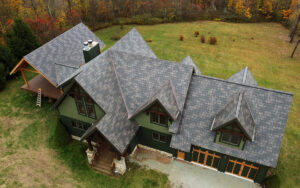When planning a metal rooftop solar installation, extensive analysis is dedicated to the precise positioning and attachment of panels to maximize solar energy production. Simultaneously, in climates with significant snowfall, additional calculations are required for the proper sizing and placement of rooftop snow guards.
However, solar contractors often lack roofing expertise, while roofing contractors rarely specialize in solar installations. Consequently, designing and installing these two different systems to ensure they work seamlessly together can be quite challenging.
The primary conflict arises because solar contractors aim to install as much photovoltaic (PV) coverage as possible, extending from end to end and eave to ridge, maximizing the roof’s surface area. This leaves little or no space for the necessary snow retention systems.
Explaining the science behind how snow retention systems work, Rob Haddock, metal roof consultant and founder of S-5! says, “There are two forces which densify a snowbank. One is the vector force, which is the snow pushing downslope parallel to the roof, and the second is the gravity load pushing straight down on the roof. These two forces amalgamate toward the eave end of the roof creating a ‘densification zone’ of sorts for the snowbank. This is where the snowbank has the greatest compressive strength.
“So, if you restrain the snow’s lower end where it has the highest compressive strength, the job is done; you’ve restrained the whole load. This is why a snow guard that is a few inches in height can restrain an entire blanket of snow that is many feet in depth.
“However, when PV modules are installed right down to the eave, this crucial densification zone for snow guard placement is obstructed. Solar panel frames are not engineered to withstand lateral snow forces, making it impossible to attach snow guards directly to the solar modules.
“Ideally, the design should leave approximately 15% of the roof surface from eave to ridge for densification at the eave end clear of solar panels. The snow retention system is then installed at the downslope edge of that zone.”
Opposing Systems
So, what happens if a roof is covered completely with solar panels, and the building owner faces issues with snow accumulation and rooftop avalanches affecting walkways, entryways and/or lower windows? A snow retention system is now needed, but where does one install the system?
“One possible solution involves installing adjacent to the lowest row of solar and elevating the snow retention system above surface of the PV array,” continues Haddock. “While this might solve the snow avalanche potential, the snow guard placement will now cast a shadow on the PV modules, thereby compromising their power production.




The net-zero Calcaire House, located in Boulder, Colorado, features seamlessly integrated solar panels and snow retention systems. Photos courtesy of S-5!
“Another proposed solution involves removing a few PV modules to make room for snow guards. While this might seem like an easy fix, it actually creates a larger problem as solar systems are highly customized on a job-specific basis. This means that the entire electrical design, must be reconfigured to different resulting power generation values. This often requires disassembly and is cost prohibitive.
“If you start deleting modules, you have to rejig the entire electrical system of that solar array. It’s a very major re-do.”
Optimized Design Integration
The ideal scenario is early collaboration between architects, solar design team, roofing contractors and snow retention manufacturers. “Everyone can huddle and address this issue in the pre-design stage,” Haddock advises. “This collaboration ensures that both systems are integrated seamlessly, but it seldom actually happens.”
A key advantage is the use of clamp-based snow retention devices, which attach directly to the standing seam roof without requiring roof penetrations. This protects the integrity of the roof and reduces the risk of leaks. Solar contractors perform their calculations, while roofing contractors, with input from snow retention manufacturers, calculate snow load requirements and determine optimal snow guard placement(s).
“It’s a travesty how often solar modules and snow retention systems are installed without proper engineering,” Haddock points out. “We’ve been preaching about this in both industries for over 30 years.”
The design also needs to consider the local fire code requirements to allow space for emergency personnel to access the rooftop in case of a fire or other disaster—yet another reason to create this “solar-free” zone down at the eave.
Case in Point
Two projects that exemplify the proper integration of solar and snow retention systems are an equestrian estate in British Columbia, Canada, and a residential compound in Boulder, Colorado.
At the British Columbia estate, a 24-gauge standing seam metal roof was outfitted with 90 solar panels. The PV system was designed in conjunction with a snow retention system to manage the region’s significant snow loads. Both systems were installed without roof penetrations, preserving the roof’s integrity and preventing leaks.
“Our multipurpose barn was designed and constructed to withstand time and elements in a challenging Western Canadian environment,” says Bruce Goode, the property owner. “The metal roof is performing exceedingly well, withstanding the heavy snow loads expected in British Columbia, and it provides an excellent platform for mounting the 90 solar panels.”
Careful planning ensured that the PV array would produce more than 30,000 kWh annually, while the snow guards provide full protection from rooftop avalanches.
At Calcaire House in Boulder, over 60 kW of solar panels were installed across multiple rooftops to meet the city’s strict energy codes. Wind loads were carefully calculated to ensure secure attachment, and snow guards were placed at the eaves. Installation began from the bottom row of panels and progressed upwards, ensuring proper alignment and integration of both systems.
The rooftops, consisting of exposed timber, stone and steel, required careful coordination to align the solar array and snow retention systems. The PV and snow retention devices were color-matched to the black roof, providing aesthetic cohesion alongside functional performance.
Drawing insights from these two successful projects, it is essential for project teams to collaboratively plan and design both PV and snow retention systems concurrently. MR

















































